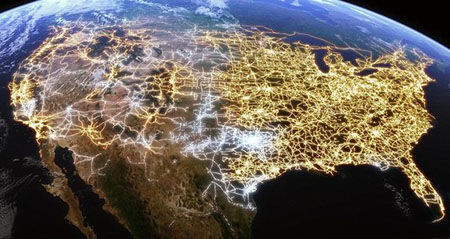by WorldTribune Staff, March 29, 2024
His teleprompter and note cards tell Joe Biden that climate change is the “existential threat” of our time. If he were to wake up to reality, or at least wake up, Biden might realize that his team’s climate policies have put the U.S. electric grid at substantial risk of failing, a Wall Street Journal editorial suggested.
“Yet in the meantime they’re ignoring how government climate policies are contributing to a looming electric-grid crisis that is more urgent and could be avoided,” the March 28 editorial said.
 Grid regulators and utilities are ramping up warnings as projections for U.S. electricity demand growth over the next five years have doubled from a year ago.
Grid regulators and utilities are ramping up warnings as projections for U.S. electricity demand growth over the next five years have doubled from a year ago.
The major culprits, the editorial said, are “new artificial-intelligence data centers, federally subsidized manufacturing plants, and the government-driven electric-vehicle transition.”
Democrat-run New York is an example of a state that is “marching toward a power shortage” as it “shuts down nuclear and fossil-fuel power in favor of wind and solar. A new Micron chip factory in upstate New York is expected to require as much power by the 2040s as the states of New Hampshire and Vermont combined.”
The editorial continued: “Electricity demand to power data centers is projected to increase by 13% to 15% compounded annually through 2030.”
A shortage of power is already delaying new data centers by two to six years, according to commercial-real estate firm CBRE Group
“Data centers — like manufacturing plants — require reliable power around the clock year-round, which wind and solar don’t provide,” the editorial said. “Businesses can’t afford to wait for batteries to become cost-effective. Building transmission lines to connect distant renewables to the grid typically takes 10 to 12 years.”
Honor their memory: The ‘shot heard round the world’
About 20 gigawatts of fossil-fuel power are scheduled to retire over the next two years — enough to power 15 million homes — including a large natural-gas plant in Massachusetts that serves as a crucial source of electricity in cold snaps. PJM’s external market monitor last week warned that up to 30% of the region’s installed capacity is at risk of retiring by 2030.
Costly regulations are another major factor.
“A soon-to-be-finalized Environmental Protection Agency rule would require natural-gas plants to install expensive and unproven carbon capture technology,” the editorial said.
The PJM report cites “the role of states and the federal government in subsidizing resources and in environmental regulation.” It added: “The simple fact is that the sources of new capacity that could fully replace the retiring capacity have not been clearly identified.”
Being an election year, the media will not likely discover this problem.
“Perhaps they’ll notice when more blackouts arrive,” the editorial concluded.
